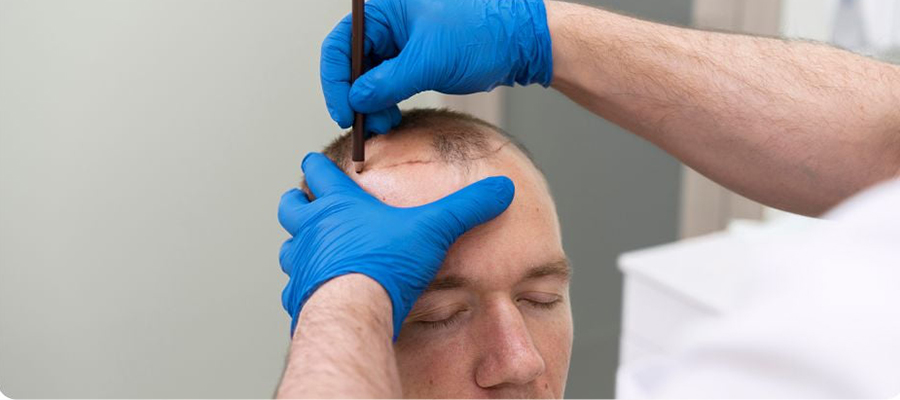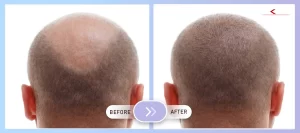
Estimated reading time: 7 minutes and 30 seconds
Hair Transplantation
Hair transplantation is a surgical procedure in which hair follicles are moved from one part of the scalp (the donor area) to another part of the scalp (the recipient area). The procedure can be performed on both men and women, and the results are generally very natural-looking.
At Aktif International Hospital, our team of highly trained and experienced surgeons use the latest in surgical and aesthetic techniques to achieve the best possible results for our patients.

Hair Transplantation Before – After
Understanding Hair Loss and Balding
Hair loss and balding can be caused by a variety of factors, including genetics, hormonal changes, and certain medical conditions. In some cases, hair loss can be temporary and can be treated with medications or other non-surgical treatments. However, in many cases, hair loss is permanent and can only be treated with a hair transplant.
Balding typically occurs in a specific pattern, with hair loss starting at the temples and crown of the head. Over time, the hairline recedes, and the bald spot on the top of the head grows larger. This pattern of hair loss is known as male-pattern baldness, and it affects the majority of men at some point in their lives.
Techniques of Hair Transplantation
Follicular Unit Transplantation (FUT)
Follicular Unit Transplantation (FUT) is a traditional technique for hair transplantation. In this procedure, a strip of hair-bearing skin is removed from the donor site and dissected into individual follicular units (grafts). The grafts are then transplanted into the recipient site.
The FUT technique is a more invasive procedure than other techniques, and it can result in a linear scar at the donor site. However, it is also a more efficient technique, and it allows the surgeon to harvest a large number of grafts in a single session.
Follicular Unit Extraction (FUE)
Follicular Unit Extraction (FUE) is a newer and less invasive technique for hair transplantation. In this procedure, individual follicular units are harvested from the donor site using a special tool.
FUE is a less invasive procedure than FUT, and it does not result in a linear scar at the donor site. However, it is also a more time-consuming procedure, and it typically requires multiple sessions to achieve the desired results.
Robotic Hair Transplantation
Robotic hair transplantation is a newer technique that uses a robotic device to assist the surgeon in harvesting follicular units from the donor site. The device is designed to improve the precision and accuracy of the procedure, and it can reduce the risk of complications and improve the overall results.
Robotic hair transplantation is a less invasive procedure than FUT, and it does not result in a linear scar at the donor site. However, it is also a more complex and expensive procedure, and it may not be suitable for all patients.

Hair Transplantation
The Hair Transplantation Procedure
The procedure is typically performed under local anesthesia, and it takes several hours to complete. During the procedure, the surgeon will carefully remove hair follicles from the donor site and transplant them into the recipient site.
After the procedure, the transplanted hair will fall out, but new hair growth should begin within 3-6 months. The new hair will continue to grow and mature over the next 12-18 months, until the full results of the procedure are visible.
It is important to follow all post-operative instructions carefully to ensure the best possible results. This may include avoiding certain activities, taking prescribed medications, and using special hair care products. Your surgeon will provide you with detailed instructions for aftercare, and you should discuss any concerns or questions with them prior to your procedure.
Benefits of Hair Transplantation
This treatment offers a number of benefits, including:
- Natural-looking results: It results in a natural-looking head of hair, with no noticeable scarring or unnatural hair growth patterns.
- Improved self-esteem and confidence: Many people who undergo hair transplantation report improved self-esteem and confidence as a result of their procedure.
- Long-lasting results: The operation results are long-lasting, and the transplanted hair will continue to grow and mature just like your natural hair.
- Minimal downtime: Hair transplantation typically requires minimal downtime, and most patients are able to return to work and normal activities within a few days of their procedure.
Risks and Complications of Hair Transplantation
It is important to discuss the risks and potential complications of the operation with your surgeon prior to your procedure, so that you are fully informed and can make an informed decision.
- Scarring: Scarring can occur at the donor site, particularly with the FUT technique.
- Infection: There is a risk of infection after the transplantation, although this risk is generally low.
- Bleeding: Bleeding can occur during or after the procedure, although this risk is also generally low.
- Unsatisfactory results: In some cases, the results of hair transplantation may be unsatisfactory, either because of poor growth or because of an unnatural appearance.
Frequently Asked Questions
Who is a good candidate for hair transplantation?
A good candidate for hair transplantation is someone with stable hair loss who has sufficient hair at the back and sides of the scalp to serve as donor hair. The ideal candidate should also have realistic expectations for the procedure and be in good overall health.
How long does the procedure take?
The length of the hair transplant procedure can vary depending on the extent of the procedure and the technique used. On average, it takes a couple of hours for the procedure to be completed.
Is it painful?
Hair transplantation is performed under local anesthesia, which helps to minimize any discomfort during the procedure. After the procedure, you may experience some soreness and swelling, but this is usually minimal and can be managed with over-the-counter pain medications.
How long does it take to see the results of a hair transplant procedure?
After the procedure, the transplanted hair will fall out, but new hair growth should begin within 3-6 months. The new hair will continue to grow and mature over the next 12-18 months, until the full results of the procedure are visible.
How long will the transplanted hair last?
The results of hair transplantation are long-lasting, and the transplanted hair will continue to grow and mature just like your natural hair.
Can hair transplantation be performed on women?
Yes,it can be performed on women, although the approach may be different due to the different patterns of hair loss that women experience. Women typically experience diffuse hair loss, which affects the entire scalp, rather than the specific pattern of hair loss seen in men.
Is hair transplantation covered by insurance?
In most cases, hair transplantation is considered to be a cosmetic procedure and is not covered by insurance. It is important to check with your insurance provider to determine if it is covered under your specific policy.
Can I return to work after hair transplantation?
Most patients are able to return to work and normal activities within a few days of the operation. However, your surgeon will provide you with specific post-operative instructions, and it is important to follow these instructions carefully to ensure the best possible results.
How do I care for my hair after hair transplantation?
Your surgeon will provide you with detailed instructions for aftercare, and it is important to follow these instructions carefully. This may include avoiding certain activities, taking prescribed medications, and using special hair care products.
Where can I learn more about hair transplantation?
If you are considering hair transplantation, it is important to discuss your options and any questions or concerns you may have with a qualified and experienced surgeon. At Aktif International Hospital, our team of highly trained and experienced surgeons can provide you with the information and guidance you need to make an informed decision about hair transplantation.
In conclusion, hair transplantation is a safe and effective procedure that can restore hair growth in areas of the scalp that are thinning or balding. With the latest and most advanced techniques, the results of hair transplantation can be natural-looking and long-lasting.
If you are interested in learning more about hair transplantation, please contact Aktif International Hospital to schedule a consultation with one of our experienced surgeons.
Author: Ekrem Güldaş
Click here to visit the website of our hair transplant centre which has branches in Istanbul and Dominican Republic.
Click here to visit the website of our hair transplant centre, which only serves in Istanbul.


 TR
TR